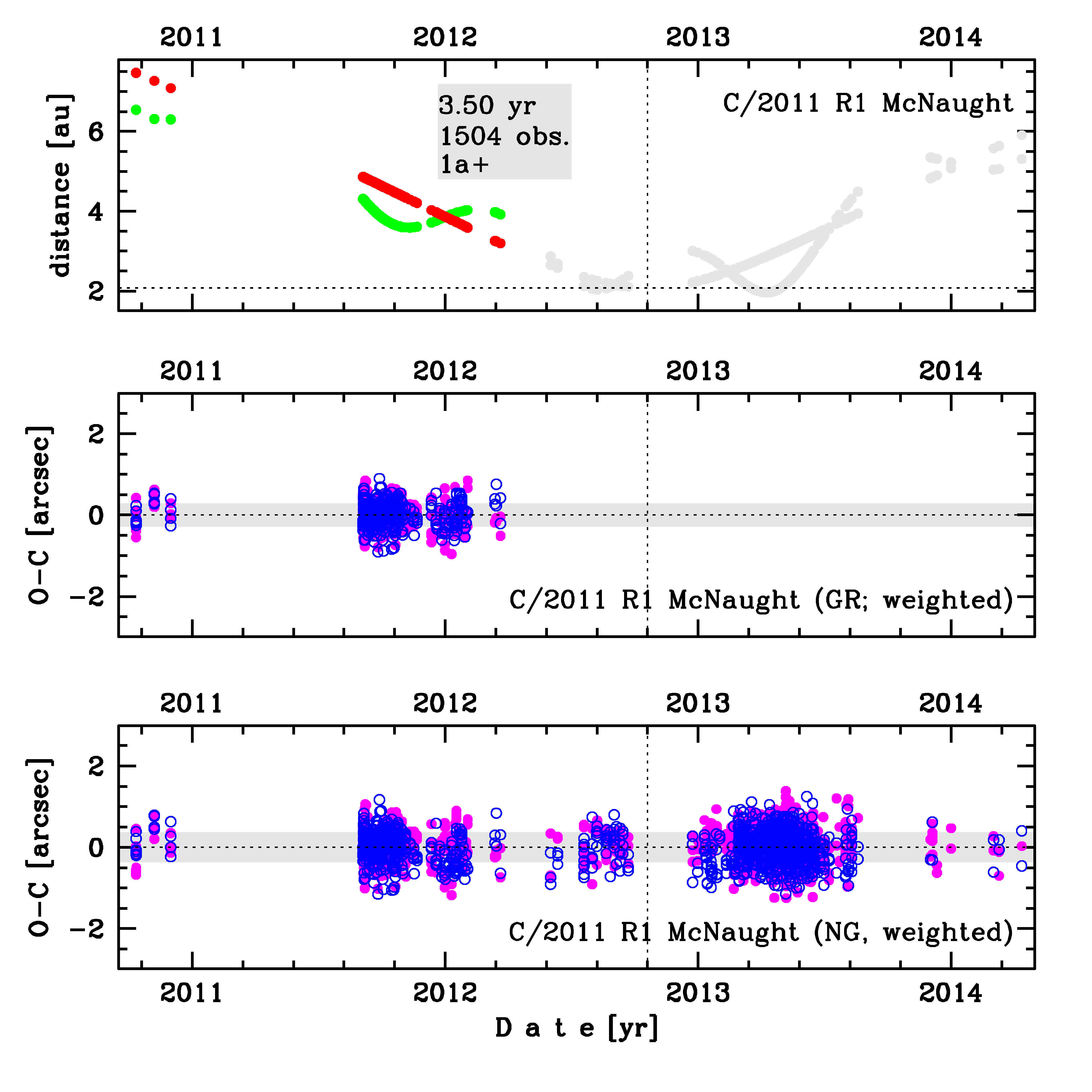C/2011 R1 McNaught
more info
Comet C/2011 R1 was discovered on 3 September 2011 by Robert H. McNaught (Siding Spring), that is more than a year before its perihelion passage. It was observed until 11 April 2014.
Comet had its closest approach to the Earth on 8 April 2013 (1.960 au), 5.5 months after its perihelion passage; however on 8 August 2012 (2.5 months before perihelion) the comet approached the Earth only a little further (2.035 au, see picture).
Solution given here is based on data spanning over 3.5 yr in a range of heliocentric distances: 7.47 au – 2.08 au (perihelion) – 5.91 au.
This Oort spike comet suffers tiny planetary perturbations during its passage through the planetary system that cause a bit tighter future orbit with original semimajor axis of about 10,000 au (see future barycentric orbits).
See also Królikowska 2020.
Comet had its closest approach to the Earth on 8 April 2013 (1.960 au), 5.5 months after its perihelion passage; however on 8 August 2012 (2.5 months before perihelion) the comet approached the Earth only a little further (2.035 au, see picture).
Solution given here is based on data spanning over 3.5 yr in a range of heliocentric distances: 7.47 au – 2.08 au (perihelion) – 5.91 au.
This Oort spike comet suffers tiny planetary perturbations during its passage through the planetary system that cause a bit tighter future orbit with original semimajor axis of about 10,000 au (see future barycentric orbits).
See also Królikowska 2020.
| solution description | ||
|---|---|---|
| number of observations | 427 | |
| data interval | 2010 10 11 – 2012 03 21 | |
| data arc selection | data generally limited to pre-perihelion (PRE) | |
| range of heliocentric distances | 7.47 au – 3.19au | |
| detectability of NG effects in the comet's motion | comet with determinable NG~orbit | |
| type of model of motion | GR - gravitational orbit | |
| data weighting | YES | |
| number of residuals | 846 | |
| RMS [arcseconds] | 0.29 | |
| orbit quality class | 1a | |
| orbital elements (heliocentric ecliptic J2000) | ||
|---|---|---|
| Epoch | 2012 09 30 | |
| perihelion date | 2012 10 19.62184072 | ± 0.00065197 |
| perihelion distance [au] | 2.07958826 | ± 0.00001036 |
| eccentricity | 1.00069866 | ± 0.00000353 |
| argument of perihelion [°] | 308.861211 | ± 0.000231 |
| ascending node [°] | 221.408199 | ± 0.000065 |
| inclination [°] | 116.196937 | ± 0.00008 |
| reciprocal semi-major axis [10-6 au-1] | -335.96 | ± 1.70 |

Upper panel: Time distribution of positional observations with corresponding heliocentric (red curve) and geocentric (green curve) distance at which they were taken. The horizontal dotted line shows the perihelion distance for a given comet whereas vertical dotted line — the moment of perihelion passage.
Lower panel (panels): O-C diagram for this(two) solution (solutions) given in this database, where residuals in right ascension are shown using magenta dots and in declination by blue open circles.
Lower panel (panels): O-C diagram for this(two) solution (solutions) given in this database, where residuals in right ascension are shown using magenta dots and in declination by blue open circles.